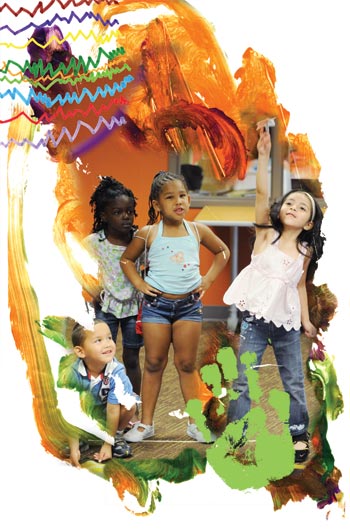 More than 45 years ago, Susan Gray conducted the first randomized clinical study with low-income children showing that an enriched environment could lead to gains in children’s language mastery.
More than 45 years ago, Susan Gray conducted the first randomized clinical study with low-income children showing that an enriched environment could lead to gains in children’s language mastery.
Her findings helped lead to the establishment of Head Start, a national school readiness program.
Today, language development for preschoolers is once again making national headlines with President Obama pledging to devote billions of dollars to early childhood education. It would be the largest federal initiative for young children since Head Start began in 1965, according to The New York Times.
Many states are putting money into pre-K education as well. Tennessee’s Gov. Phil Bredesen instituted voluntary pre-K in 2005, channeling $213 million into a program that serves 18,000 young children with thousands more on the waiting list.
Current research by early language development specialists at Peabody into curricula, programs and methods that work continues to provide a vital foundation for educators and decision makers.
Gray, a developmental psychologist and Peabody professor for whom Peabody College’s Susan Gray School is named, focused on children at risk for school failure because of poverty, and that effort continues among Peabody
researchers such as Dale Farran.
Other early childhood education researchers at Peabody search for new ways to help children with motor or cognitive delays, autism, congenital defects such as cleft palates, children who learned another language first, and typically developing children who have slipped through the cracks.
There are ongoing large-scale outcome studies involving multiple school systems and smaller scale experiments designed to find out how children learn language and why and what works best. All are equally important to informing future public policy decisions, researchers say.
“Sometimes research does not uphold what you might advocate,” said Farran, professor of education and psychology. “That doesn’t mean that we stop advocating ways to treat children well or stop caring about children and thinking about how to make their lives better.”
Starting young
Baby instructional videos are a good example of a well-intentioned teaching tool aimed at young children that doesn’t pan out.
In Georgene Troseth’s lab, a toddler watches a video of Troseth hiding Pooh Bear under a table. But when led into the same room, configured in exactly the same way, he can’t find the stuffed animal.
That was an early example of groundbreaking research findings by Troseth, associate professor of psychology, and others showing that while television shows and videos can serve an educational function for children older than three, those aimed at children younger than three are not effective teaching tools. Babies and toddlers don’t understand that what they see in a video represents something in real life.
“What I’m looking at is how and under what conditions very young children begin to realize that nonlinguistic symbols represent something else,” Troseth said.
Troseth’s current research explores whether videos are effective teaching tools for children with autism. She has ongoing research to find out how videos might better be used for instruction, such as training parents and teachers to stop videos to ask questions and launch discussions, much as they would when reading a book.
 For children under three, parents provide critical feedback and narration as children develop early language skills, say Troseth and others at Peabody.
For children under three, parents provide critical feedback and narration as children develop early language skills, say Troseth and others at Peabody.
“Parents are children’s first language teachers and most parents are very good teachers,” said Ann Kaiser, professor of special education and Susan Gray Professor of Education and Human Development. “When parents’ teaching doesn’t work, it’s usually because the child needs a different kind of teaching or more support to learn language.”
Kaiser directs several projects aimed at teaching strategies to parents to help support their children’s language development. She also is interested in finding ways to identify and help children with potential language learning difficulties before they reach kindergarten. Kaiser’s new research project targets children in the 24- to 36-month age range who are typically developing cognitively but have delayed language production and comprehension.
“This is a population of kids who don’t qualify for early intervention because they only have language delays. The usual prescription is: Wait and see. Some of those kids will be just fine, and some will not be just fine,” Kaiser said.
Generally, children who enter school with lower language abilities don’t do as well in school as their peers with typical language—but that’s not true for every child, Kaiser said. Some catch up to their peers after a period of time because they learn from the language-rich environment. Identification of those who won’t catch up without systematic early intervention is critical.
“Persistent low-language kids over time are more likely to have reading problems,” Kaiser said. “So we want to figure out: Who are these children? How can we predict which kids will have persistent language problems over time? And how can we get intervention for them earlier?”
It’s all about efficiency. How can we accelerate development for low-language kids? Can we get them back on a trajectory that looks like typical development by the time they get to kindergarten so they can take advantage of the learning environment and run with it?
~ Ann Kaiser, professor of special education and Susan Gray Chair in Education and Human Development
“It’s all about efficiency,” Kaiser said. “How can we, in a way that’s developmentally appropriate, accelerate development for these kids? Can we get them back on a trajectory that looks like typical development by the time they get to kindergarten so they can take advantage of the learning environment and run with it?”
Language talk
In one project, Kaiser and David Dickinson, professor of education and chair of the Department of Teaching and Learning, are following 445 children in the Head Start program in Birmingham, Ala.
Some of those classrooms have implemented a curriculum co-authored by Dickinson called Opening the World of Learning (OWL), which provides guidance to teachers helping children build vocabulary and basic literacy skills.
Some of the classrooms that used the OWL curriculum also use Kaiser’s Enhanced Milieu Teaching (EMT) for children with lower language abilities. EMT was developed primarily for children with significant language delays such as children with autism and Down syndrome. It has been used in other studies with children at risk for language delays.
“One interesting thing that we’re doing is seeing if we can identify critical ingredients in classroom interactions that relate to children’s growth” with a focus on what teachers are doing that works well, Dickinson said.
 The researchers have found that explicit talk about vocabulary is associated with faster learning. He noted, “Getting teachers to talk explicitly about language requires a real shift in the standard ways of teaching and interacting with young children.”
The researchers have found that explicit talk about vocabulary is associated with faster learning. He noted, “Getting teachers to talk explicitly about language requires a real shift in the standard ways of teaching and interacting with young children.”
While it can be challenging to demonstrate that a particular program substantially affects children’s language learning, Dickinson said new findings from a study combining results from eight different programs that served more than 3,000 children and used OWL have shown evidence for the first time that specific conceptual teaching practices aimed at 4-year-olds have measurable impact on language skills by the end of fourth grade.
An increased impact
Debbie Rowe, associate professor of early childhood education, and others have been studying ways to help preschool children learn language and master other tasks by developing better writing skills, which some research has shown are just as important to school success as early reading skills.
Rowe and Dickinson are co-investigators on a project for Early Reading First (ERF), a Bush administration initiative designed to create “spires
of excellence” in preschool classrooms. The project uses both the OWL curriculum and strategies for integrating writing experiences into the children’s daily work and play. A third component targets
English language learners, who make up about a third of the classroom population of the study. That project, in partnership with the Metropolitan Nashville Public Schools, the Nashville Public Library and the YMCA, involves 13 preschool classes.
The graduates of the preschool classroom attend a summer camp at the Y designed to provide fun social interactions and re-expose them to learning opportunities before they begin kindergarten (see “Project Lift Off,” p.16). This is an important component for children heading to kindergarten from homes where English is not the primary language.
 As part of the project, parents are provided with materials to help enrich learning at home. The project also shares critical data regarding the students’ progress with teachers on an ongoing basis. It is the kind of data that has been used to evaluate the OWL curriculum in at least nine other programs.
As part of the project, parents are provided with materials to help enrich learning at home. The project also shares critical data regarding the students’ progress with teachers on an ongoing basis. It is the kind of data that has been used to evaluate the OWL curriculum in at least nine other programs.
“We have seen very encouraging patterns of increasing impact across the range of language and literacy,” Dickinson said. “This doesn’t mean this curriculum is what’s critical. It is part of the picture of adequate funding for sustained coaching and attention to quality as well as ongoing evaluation and assessment as part of the whole ERF approach.”
Carin Neitzel, assistant professor of early childhood education, has worked with Rowe and Dickinson on the ERF project and with Rowe in conducting a three-year longitudinal study of children ages 2 to 5. The study aims to find ways to engage children in writing at an earlier age.
While the conventional wisdom is that children learn to read first and then write, contemporary research shows that preschoolers can learn “in a much more holistic way,” Rowe said.
“Kids learn how to write the same way they learn to talk,” Rowe said. “If we invite children to write words and respond to their meanings, they make amazing discoveries about how print works.”
Tools and training are key
Training teachers and providing them with tools, such as curricula, is critical to the success of any pre-K program, Farran said. “These curricula provide a way of organizing the year and making it logical for children,” Farran said
Farran and Neitzel both are interested in whether children taught to be self-regulated learners in preschool fare better later on, with more success in learning language and other skills. There is a growing body of research about children who are self-regulated learners, who tend to know when it’s appropriate to ask for help and are able to follow directions and sustain attention Farran said. She and her colleague, Mark Lipsey of the Peabody Research Institute, have launched a study in some Tennessee and North Carolina preschools that seeks to determine how to encourage that style of learning.
“Those skills are almost as predictive as early reading,” Farran said. But better outcome measures are needed as well as stricter measurement guidelines, which are part of the current study.
Farran is among researchers at Peabody who welcome the renewed emphasis on pre-K education. But she approaches the subject with caution.
“As popular as universal pre-K is, we have very little in the way of longitudinal studies,” she said. “A lot of what we rely on for informing legislation came from small studies in the 60s. The issue is how you go to scale once we find things that work in very small environments. We have a lot of scaling up going on right now.”
Farran and Lipsey directed a recently completed study that followed pre-K children in six rural Middle Tennessee counties through the third grade to find out if children using specialized language learning curriculums scored higher on standardized tests. The children were taught in public schools by licensed teachers in quality facilities using three different groupings of materials: a literacy-based curriculum, a development-based curriculum and what Farran termed “business as usual.”
 Farran found that children provided the literacy or development curricula by teachers trained to use them fared better than those exposed to more traditional preschool methods. Rural children, even from poor families, tend to have better “entering skills” than children in cities. The next step is to carefully look at urban school systems, she said, where the poverty, overstimulation, grit and chaos of cities creates a more challenging learning environment for young children.
Farran found that children provided the literacy or development curricula by teachers trained to use them fared better than those exposed to more traditional preschool methods. Rural children, even from poor families, tend to have better “entering skills” than children in cities. The next step is to carefully look at urban school systems, she said, where the poverty, overstimulation, grit and chaos of cities creates a more challenging learning environment for young children.
Lipsey and Farran have received funding to evaluate Tennessee’s pre-K system longitudinally to determine whether quality preschool curricula have an effect on standardized testing by third grade (see sidebar, right).
“This is very hard to do. Tennessee’s system is not universal and there are fewer preschools than children who want them,” she said, adding that enlisting local school systems in randomized studies is difficult.
The study has two parts, one of which relates to practices in the classroom and the other to literacy education.
Farran said it’s important not to commit to one kind of research, curriculum or technique. She holds up Susan Gray as a model of someone who cared about children and constantly thought about ways to make their lives better.
“When you go back to Susan Gray and the work that she did in the ’60s here, there’s a long, stellar history that we need to maintain,” Farran said. “She was an incredible combination of a serious researcher and a staunch advocate.”
New Peabody institute to conduct first-ever assessment of Tennessee’s pre-K program
The Peabody Research Institute and the Tennessee Department of Education have announced a partnership to conduct the first statewide evaluation of the effectiveness of Tennessee’s Voluntary Pre-K Program.
“Tennessee has always been a leader in providing early education for children, and I continue to be committed to our pre-K program,” Gov. Phil Bredesen said. “I am excited that we can now take a long-range look at the program and hopefully be a model for the nation.”
The five-year, $6 million statewide scientific study is being funded by a grant from the U.S. Department of Education’s Institute of Education Sciences and is being conducted as a collaborative project by the two groups.
The study will examine the effectiveness of Tennessee’s pre-K program for enhancing children’s readiness for kindergarten and improving their achievement in later grades. The goal is to gather data to make informed decisions concerning the program and to identify areas of improvement to increase its overall quality.
“We are very pleased to collaborate with the state of Tennessee and its Office of Early Learning on a project of this magnitude. It has the potential to strengthen education policies and practices for Tennessee’s earliest learners and for pre-kindergarten students across the nation,” Dean Benbow said.
Pre-K classes from across the state will participate in the study on a voluntary basis. The first phase of the study began in May. There is no cost to the local education agencies or parents involved in the process.
—Jennie Edwards